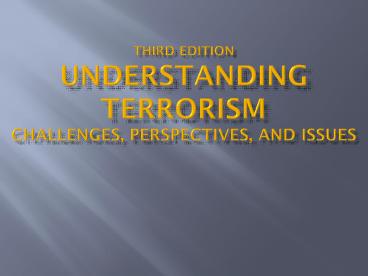Third Edition Understanding Terrorism Challenges, Perspectives, and Issues - PowerPoint PPT Presentation
Title:
Third Edition Understanding Terrorism Challenges, Perspectives, and Issues
Description:
Violent Ideologies Terrorism From the Left and Right From the Left Fringe to the Right Fringe Fringe-left: Extreme, often violent, interpretation of Marxist or other ... – PowerPoint PPT presentation
Number of Views:117
Avg rating:3.0/5.0
Title: Third Edition Understanding Terrorism Challenges, Perspectives, and Issues
1
Third EditionUnderstanding TerrorismChallenges,
Perspectives, and Issues
2
Chapter 7
- Violent Ideologies
- Terrorism From the Left and Right
3
The Classical Ideological Continuum
- From the Left Fringe to the Right Fringe
- Fringe-left Extreme, often violent,
interpretation of Marxist or other leftist
ideologies. - Far-left Radical interpretations of Marxist or
other leftist ideologies that are usually
non-violent. - Liberalism Policy agenda promoting peoples
rights. Expectation of positive government role. - Moderate center Usually largest segment in
democracies.
4
The Classical Ideological Continuum(continued)
- From the Left Fringe to the Right Fringe
- Moderate center Usually largest segment in
democracies. - Conservatism Traditional distrust of change or
government intervention. - Far-right Strong adherence to social order and
tradition. - Fringe-right Uncompromising, often violent,
belief in ethnonationalist or religious
superiority.
5
The Classical Ideological Continuum(continued)
6
The Classical Ideological Continuum(continued)
- Ideologies and Ideals
- Ideologies Systems of belief.
- Anarchism Minimal central governmental control.
- Propaganda by the deed.
- Marxism Class warfare leading to a communist
dictatorship of the proletariat. - Fascism Strong antidemocratic, anti-Communist
belief in law and order. - Often ethnocentric and militaristic.
7
A Comparison of Ideologies
8
Left-Wing Ideologies and Ideals
- Class Struggle
- Orthodox Marxism.
- Relationship to the means of production.
- Goal Dictatorship of the proletariat.
- Leftist Nationalism
- Selective application of Marxist theory.
- Rooted in Cold War rivalries.
- Wars of national liberation.
9
Left-Wing Ideologies and Ideals(continued)
- Special-Interest Extremism
- Single-issue terrorism.
- Cases Environmentalism. Peace movements.
- Problems on the Radical Left
- Marxist revolutions occurred in the developing
world. - Infighting about the revolutionary party.
- Soviet versus developing world Communism.
- Working classes in the West never acquired a
revolutionary consciousness.
10
The Industrial Age Class Pyramid
11
The Terrorist Left
- Case Latin America
- Colombia
- FARC
- National Liberation Army
- Peru
- Shining Path (Sendero Luminoso)
- Tupac Amaru Revolutionary Movement (MRTA)
- Argentina
- Montoneros
12
The Terrorist Left(continued)
- Case Europe
- Italy
- The Red Brigade
- Years of Lead
- Germany
- Red Army Faction
- June 2nd Movement
- Northern Ireland
- Provisional Irish Republican Army
- Irish National Liberation Army
13
Leftist Terrorism in Latin America
14
Leftist Terrorism in Europe
15
Right-Wing Activism and Extremism
- Political Parties and Dissident Movements
- Reflect the distinctive features of national
environments. - Neofascist political parties in Europe and Latin
America. - Unorganized or partly organized dissident
movements. - Tradition and Order
- Defenders of a supreme principle such as a new
order. - Scapegoating enemy groups.
16
Right-Wing Activism and Extremism(continued)
- Right-Wing Nationalism
- Notion of a superior national group or race.
- Loyalty to the superior group.
- Subordination of inferior groups.
- Religion and Mysticism
- Not universal traits on the reactionary right.
- Common in America.
- Less common in Europe or Latin America.
17
Scapegoats of the Reactionary Right
18
The Terrorist Right
- Case Europe
- Germany
- Usually street-level confrontations.
- Italy
- Random attacks by small fascist-leaning groups.
- Turkey
- Grey Wolves.
- Northern Ireland
- Ulster Volunteer Force (UVF)
19
Violent Ideologies in the New Era
- The New Terrorism
- Difficult to classify as left or right
terrorism. - The Terrorist Left in the New Era
- Defeat of the urban guerrillas.
- A few remaining rebels in the hills.
- Some grass-roots neo-anarchist activism.
- The Terrorist Right in the New Era
- Continued scapegoating.
- Rightist ractions to unpopular agendas.































